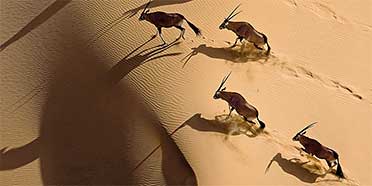
Namibia Travel Guide Best Time To Visit
Anthony is the author of the 'Botswana & Namibia' Lonely Planet guide.
The best time to visit Namibia is during the Dry season (May to October). However, it can be visited year-round as the climate is generally dry and pleasant. Wildlife viewing in all parks, but especially in Etosha National Park, is best in the drier months. In the Wet season (November to April), animals move away from the waterholes and scatter around the parks. Between December and March, some days will be humid and rain may follow, often in localized afternoon thunderstorms.
May to October Dry Season – Winter
-
Wildlife gathers around rivers and waterholes, making animals easier to spot – this is the best time to visit Etosha National Park
-
It’s sunny with no clouds and there is virtually no rain
-
Even though most tourists visit during the Dry season, the parks still don’t feel crowded (except for Etosha and parts of Namib-Naukluft National Park)
-
It gets cold at night and in the mornings; pack warm clothes for morning game drives from June to August
November to April Wet Season – Summer
-
The scenery is greener and there are newborn animals
-
Rates are lower because it’s low season
-
Migratory birds are present and birding is at its best
-
Rains are mostly short showers in the afternoon and rarely have a negative impact on your trip
-
It gets very hot from October or November to March
-
It’s more difficult to spot animals, especially in Etosha
Wildlife Photos
Cheetah
© WerksdesigOryx standing in front of a dune
© Ariadne van ZandbergenGreater kudu on the hilltops
© Michael PolizaSpringbok running
© Michael PolizaBlack-faced impalas fighting
© Ariadne van ZandbergenLion cub resting
© Ariadne van ZandbergenBlack rhinoceros eating
© Ariadne van ZandbergenGround squirrel eating
© Ariadne van ZandbergenRed hartebeest among yellow flowers
© Ariadne van ZandbergenGemsbok in a beautiful landscape
© Ariadne van ZandbergenPlains zebras fighting
© Ariadne van ZandbergenImpala drinking
© PattrickJSBlack-backed jackals playing around
© Ariadne van ZandbergenWhite rhinoceros eating grass
© Ariadne van ZandbergenGiraffe
© WerksdesigOryx in the dunes
© Ariadne van ZandbergenOryx running through the dunes
© Ariadne van ZandbergenCape fur seal colony
© JennieByassCape fur seal on a rock
© Ariadne van Zandbergen Best Time To Go by Major Park
If seeing wildlife is your main objective, the best time to visit most parks, especially Etosha, is in the Dry season (May to October). Namibia is a scenic country and can be visited throughout the year. The colors will be most vibrant during and after the Wet season (November to April). From October or November to March it can be unpleasantly hot.